Activity Reports:About Us :Sendai Creative Forum 2009 "Crossing Creative Powers - Local to Global, Global to Local -" Summary
Sachiko Kanno
Japan Foundation Information Center
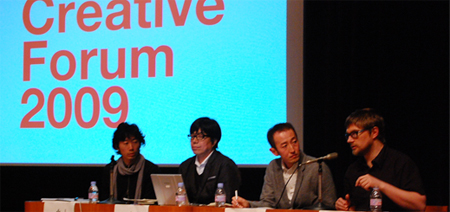
The Japan Foundation has been co-organizing seminars and symposia with actors in communities to stimulate international cultural exchange activities in their communities.
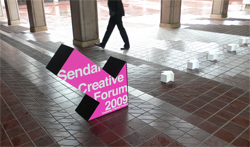 Following the symposium "Stimulating Cities with Art" in Kanazawa City in 2008, the Japan Foundation co-organize Sendai Creative Forum 2009 with Sendai City and the Miyagi Museum of Art, entitled "Crossing Creative Powers - Local to Global, Global to Local -" on March 23, 2009.
Following the symposium "Stimulating Cities with Art" in Kanazawa City in 2008, the Japan Foundation co-organize Sendai Creative Forum 2009 with Sendai City and the Miyagi Museum of Art, entitled "Crossing Creative Powers - Local to Global, Global to Local -" on March 23, 2009.
In Sendai City and its neighboring areas, there is a movement to revitalize the cities by creative activities in the fields of media art, contemporary, art, architecture, and design. Sendai-based creators are active globally. It is now required to build networks with international platforms that engage in similar activities and to extend personal networks by sharing information and know-how.
We organized the symposium with Mr. Masashige Motoe (Associate Professor at Graduate School of Tohoku University) as a moderator and the following panelists: Mr. Drew Hemment (Director & CEO of "Futuresonic"), Mr. Hide Nakaya (Navigator in NHK TV program "Digital Stadium"), Mr. Meruro Washida (Curator at 21st Century Museum of Contemporary Art, Kanazawa), and Mr. Naoto Ogawa (member of "logue"). They discussed the possibilities of international art festivals to prime the revitalization of cities by prompting to generate ideas and exchanges, rather than to be mere presentations or exhibitions of art. They also discussed how important for people with creative potential in local communities to send out their messages to connect to each other to form a global network.
Sendai Creative Forum 2009
"Crossing Creative Powers - Local to Global, Global to Local -"
Summary
Date: Sunday, March 22, 2009 at 14: 20 to 17: 00 (Opened at 13: 30)
Venue: Lecture Hall at The Miyagi Museum of Art (Aoba-ku, Sendai)
Organizers: The Japan Foundation, Senday City, The Miyagi Museum of Art
Supporter: British Council
Cooperator: Creative-related Urban-type Festival Research Society (FesLab)
>> Click here for the notice and profiles of participants (In Japanese)
1. Organizers' Address
Ms. Mihoko Himeda, Assistant Managing Director of the Japan Foundation Information Center, made an opening address stating that the Japan Foundation expected further progress in the movement of creative cities in local communities, the revitalization of local communities through art, and the activities of international cultural exchange.
Mr. Gen Amano, Director, Industry Promotion Section, Industrial Policy Department, The City of Sendai, made a greeting speech and described the policy of Sendai City.
Sendai City is expected to face a declining population in years to come due to the increase of population outflow. Therefore, the city is now striving for improvement of the citizens' quality of life rather than its quantitative expansion. That is the reason why Sendai City is adopting the concept of "creative city" that is attracting a global interest. The city encourages promoting a collaborative relationship among industry, government and academia to promote creative industry.
2. Presentations of Model Cases
Presentation of "Futuresonic" by Mr. Drew Hemment
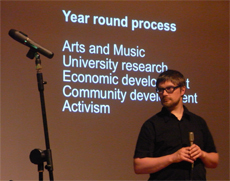 "Futuresonic" is now known as a leading digital art festival in the U.K. Manchester, the host city of the festival, is a city with a population of 600,000 with various cultural backgrounds. In a city of the size of Manchester, we have an advantage to produce a more open event that covers different genres of culture. Manchester and Sendai share common characteristics such as the size of the city and the distance from the capital. Manchester achieved the economic development as the first city of industrial revolution in England. After the Second World War, however, its economy declined rapidly. Today, it is undertaking the revitalization with the power of culture.
"Futuresonic" is now known as a leading digital art festival in the U.K. Manchester, the host city of the festival, is a city with a population of 600,000 with various cultural backgrounds. In a city of the size of Manchester, we have an advantage to produce a more open event that covers different genres of culture. Manchester and Sendai share common characteristics such as the size of the city and the distance from the capital. Manchester achieved the economic development as the first city of industrial revolution in England. After the Second World War, however, its economy declined rapidly. Today, it is undertaking the revitalization with the power of culture.
The mission of "Futuresonic" is to stimulate the city as the stage and revitalize it to transform into an energetic city. Futuresonic is a community-based festival that provides opportunities for artists in the community to connect to international communities and creative visions. What makes this festival so unique is the fact that it is organized as part of academic researches in a close collaboration with universities. This festival is contributing many researches by providing university researchers with a platform for experiments and presentations. We have been seeking the way to make the festival creative. From now on, Futuresonic has three main strands: Art, Music, and Ideas. To involve with various genres and people, the festival will be renamed to FutureEverything.
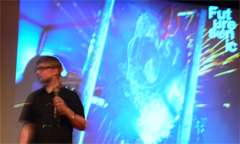 The theme of Futuresonic 2009 and the Social Technologies Summit is social media and social networking. When the festival is on the cutting edge of new cultural trends, companies are eager to participate in to obtain information. As a result, it can contribute to academic researches and economic development.
The theme of Futuresonic 2009 and the Social Technologies Summit is social media and social networking. When the festival is on the cutting edge of new cultural trends, companies are eager to participate in to obtain information. As a result, it can contribute to academic researches and economic development.
Although the festival itself is held only for three days per year, numerous activities are required for preparation and follow-up. Therefore, we regard it as a year-round project. In addition, it is a valuable opportunity to gather artists, companies, and citizens that benefits the local community.
I'd like to conclude this presentation with Charles Landry's quote: "Making cities, there is no formula."
Presentation of International Festival Laboratory by Shinya Kakizaki
"FesLab" is short for Festival Laboratory, an organization to research activities such as the one led by Mr. Hemment. FesLab is also a producer of the exhibition "Occur" that is held at this museum (The Miyagi Museum of Art). The word of "Occur" comes from a Latin word that symbolizes a current (river) is about to run out of its source. We name the exhibition "Occur" in hope that Sendai city can be the center of new art movement. FesLab has been researching how an event should be organized and aiming to build a platform where artists can engage in cross-cutting discussions, stepping out of their own fields of art, such as architecture, music, etc. Currently, FesLab is working on the first festival to be held in autumn 2010, but the number of creators in Sendai City is not yet enough. Therefore, our objective is to foster producers and directors as well as to discover creative talents among the young generation to encourage them to be designers, composers, and artists of various fields.
3.Panel Discussion
Moderator: Masashige Motoe, Associate Professor at Graduate School of Tohoku University
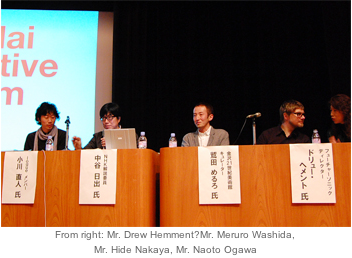 Naoto Ogawa (Member of "logue"): The name "logue" comes from the word "Dialogue." "-logue" means speech or discourse. At first, a hyphen "-" was prefixed to "logue." However, we found that a hyphen means "except for" in the web search and thus our name did not appear in the search results. That is why we omitted the prefixed hyphen from our name. "logue" started as part of a study group to promote creative industry in Sendai City. Over six months, we held interviews and lectures with various creators living in Sendai and updated reports on these events on the web everyday. After temporary suspension, we recently resumed our activity. Our new objective is how to define the term "local." In other words, we want to know how people regard Sendai City as a local city in contrast with Tokyo. We are seeking a new definition of "local city" apart from the existing concept of local cities versus the capital city.
Naoto Ogawa (Member of "logue"): The name "logue" comes from the word "Dialogue." "-logue" means speech or discourse. At first, a hyphen "-" was prefixed to "logue." However, we found that a hyphen means "except for" in the web search and thus our name did not appear in the search results. That is why we omitted the prefixed hyphen from our name. "logue" started as part of a study group to promote creative industry in Sendai City. Over six months, we held interviews and lectures with various creators living in Sendai and updated reports on these events on the web everyday. After temporary suspension, we recently resumed our activity. Our new objective is how to define the term "local." In other words, we want to know how people regard Sendai City as a local city in contrast with Tokyo. We are seeking a new definition of "local city" apart from the existing concept of local cities versus the capital city.
Meruro Washida (Curator at 21st Century Museum of Contemporary Art, Kanazawa): As a curator, I involved in Kanazawa Art Platform in fall of 2008 organized by 21st Century Museum of Contemporary Art, Kanazawa. With the theme "To Create Our Own Place by Ourselves," the exhibition was situated around the center of the city of Kanazawa. Each of 19 artists from Japan and abroad was allocated a venue, including vacant shops and houses, to hold a workshop or an event. We offered a tour to visit each venue. This project had two main objectives: first, we tried to involve as many and various citizens as possible to bring this project into action. Second, we cared for the places to use as venues. For example, we looked for shrines and traditional Japanese-style houses to offer to 19 artists and management staff to work together to create artworks, and a tour was provided to connect each venue.
I am also a member of CAKK (Center for Art & Architecture, Kanazawa), a group of artists, students, and architects living in Kanazawa. CAKK's activities include: renting houses in Kanazawa city to provide artists with places to stay; hosting exhibitions, workshops, and other events. Aside from government-led activities, people who want to make things happen in the city come together for CAKK. Our activities are cross-cutting between architecture and art. We are now aiming at building an alternative network among historic cities around the world, such as Seoul, Okinawa, Shanghai, Taipei, and those in Benelux countries.
Hide Nakaya (NHK Commentator): I have been a navigator in a TV show called "DigiSta (Digital Stadium)." From the beginning, "DigiSta" is more than just a TV show to me; it is a movement with a vision for the future. In other words, it is a field to foster creators who can be world-class artists. I want these creators to see the world and to introduce Japanese contents to audience around the world. I believe that accumulation of such activities will make various movements happen.
Sendai City, Miyagi Prefecture, is a popular city with high level of culture, especially in arts. This city seems to be appropriate for the movement of art festival. However, some requirements are yet to be filled: needs of the citizens, love for the festival, and acknowledgement of the festival. Most of all, though, a crucial factor is an actor like FesLab. For instance, the greatest festival movement in the world is Festival international de la bande dessinée d'Angoulême. Angouleme, France, is a city of printing and paper-making industry with a population of 46,000. This annual festival attracts over 200,000 fans from around the world.
The city has been inviting contents-related companies from throughout the country to the area around the National Center of Manga and Image (CNBDI) and the research center and school of visual arts, resulting in creation of new jobs for 600 people. CNBDI is located in an old small castle, so the atmosphere is quite sophisticated. School children can visit the office to see young creators are working on CG pictures. I believe that Sendai City can learn lessons from Angouleme in terms of how a local community is striving to surpass Hollywood.
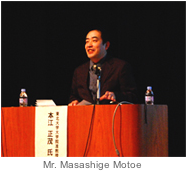 Another favorite city of mine is Laval, a town near Le Mans in France. The mayor of the town has been promoting science technology industries. A festival for virtual reality called "Laval Virtual" started a decade ago. This small town receives virtual-reality fans from around the world and enjoys this cutting-edge technology. Here, virtual reality is used in an easily comprehensible manner and the world's first outdoor theme park is located in the town. There is also Laval Mayenne Technopole. I believe that it is important to establish a place for education and events to propagate information and receive people from around the world.
Another favorite city of mine is Laval, a town near Le Mans in France. The mayor of the town has been promoting science technology industries. A festival for virtual reality called "Laval Virtual" started a decade ago. This small town receives virtual-reality fans from around the world and enjoys this cutting-edge technology. Here, virtual reality is used in an easily comprehensible manner and the world's first outdoor theme park is located in the town. There is also Laval Mayenne Technopole. I believe that it is important to establish a place for education and events to propagate information and receive people from around the world.
The Academy Award in the United States has achieved today's prosperity because it is based on the academy, an organization for research. It is important that research institutes keep producing new technologies and ideas to drive the movement.
Hemment: I have a question to Mr. Ogawa. Does your organization have an on-line community?
Ogawa: Actually, our activities are based on face-to-face interactions instead of SNS. A community can be defined as local by its size: that is, people can meet face to face anytime they want.
Hemment: The Internet can be used to propagate activities of an organization to the world and to revitalize a local community. The case of Kanazawa impressed me with its attitude to value interactions with people in the local community. How could you succeed in involving them in the project?
Washida: The key to success is to provide various ways of involvement. It is important for the participants to launch a project by themselves.
Motoe: Let me summarize the discussion up to this point. There are four points of discussion: 1. City; 2. Core organization; 3. The way to win and involve the audience; 4. Technology and media. In particular, I'd like to ask each of you the relationship between the city and your work. In what kind of places and how does the city relate to your work?
Hemment: There are two kinds of festival. One is a kind of festival that does not have little relation to a specific city; for instance, a traveling festival that goes from one city to the next. The other is a kind of festival that is deeply linked to a specific city. It is a festival that has its roots in the particular city. "Futuresonic" is the latter, and it can't be organized in any other city. I want to change the city through close communication with people in the city. The festival and the City of Manchester have been mutually affect each other, and both have been undergoing changes.
Washida: Kanazawa is a city of intense connections among people in communities. They can build cross-sectional connections. With low rents, they can rent spaces for their activities within their allowances. The size of Kanazawa City is appropriate for launching projects with advantages of local environment.
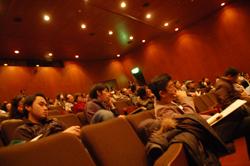 Nakaya: I agree. In the era of globalization, physical distance between the capital and a local city does not matter to people abroad. What is required for a local city is to make the festival popular outside Japan. It does not have to compete with other cities to be the world's greatest festival; or rather it should aim at creating a unique festival. People in Angouleme, France, are keenly interested in Japan. Children in France are growing up with Japanese animation programs and they come to know later that these are made in Japan. They say they want to work in Tokyo, Japan. Tokyo, Japan is now a city of admiration from the world, but Japanese people are last to know such trend. I believe it is important for Japan to deliver the information aggressively while people around the world have a positive impression on Japan.
Nakaya: I agree. In the era of globalization, physical distance between the capital and a local city does not matter to people abroad. What is required for a local city is to make the festival popular outside Japan. It does not have to compete with other cities to be the world's greatest festival; or rather it should aim at creating a unique festival. People in Angouleme, France, are keenly interested in Japan. Children in France are growing up with Japanese animation programs and they come to know later that these are made in Japan. They say they want to work in Tokyo, Japan. Tokyo, Japan is now a city of admiration from the world, but Japanese people are last to know such trend. I believe it is important for Japan to deliver the information aggressively while people around the world have a positive impression on Japan.
Ogawa: People of my generation have a sense of community that is different from traditional love for home province. It will be more effective if people can obtain what they like or appreciate without going through a path of local-to-capital.
<Questions and Answers with Audience>
Q1: I think what is great about the festival in Manchester is that people of various generations enjoy it. What kinds of efforts do you make to make people of various generations understand the festival?
Hemment: We provide a variety of events such as talk session, workshops, and exhibitions.
Q2: I'm a female plasterer. By reviewing case studies presented today, I would like to incorporate visual material in my work. Could you give me any idea?
Nakaya: Business opportunities can be found anywhere other than in long tail. It is often said that such business is difficult under economy crisis, but it is not true. I want you to work with confidence to be the only one plasterer that no one else in the world can be.
Q3: 1. I think it is difficult to manage an organization to launch a large-scale event. How did you launch such an organization? 2. How did you recruit staff and volunteers? 3. What kind of budget do you win, and from what kind of organization, to manage the festival?
Hemment: Up until a few years ago, my organization was quite small and I had to do everything by myself. Then, the Arts Council offered a grant to exhibitions and we could hire an excellent manager. This manager handled management and fund-raising with new perspectives and ideas that I had never thought. Now I can focus on the creative aspects and researches. Regarding fund-raising, I can't say that we have enough money. In many occasions, however, people who love this kind of work are offering their help, and artists, collaborators, and commissioners are offering their cooperation or participation as a field of new experiment or presentation.
<Comments from panelists>
Ogawa: It would be nice if some of you happened to visit this museum today and decided to join this symposium on the spot.
Nakaya: Your effort will be meaningless if you don't continue. In this sense, involvement of local government is important. It is understandable that local governments are suffering from economic crisis, but I hope they can overcome it with their wisdom and efforts.
Washida: Referring to a question from the audience about efforts to make people of various generations understand the festival, in case of Kanazawa, I believe we shouldn't persuade people to understand our project. As strangers from outside the community, we have to make efforts to make people let us join in the local community. For elderly citizens, it is hard enough to go out to places where people gather. Therefore, we have to care for them by providing places where they can observe events. It will be excellent if art can be a trigger for such kind of communication. In other words, it is more important to share the occasion with people in the community than persuading them to understand the project.
Hemment: It is really hard to launch a new festival. It is also really hard to make new challenges and attempts. Feslab is quite a stimulating attempt, and I'm glad to know that new attempts are spreading in Sendai City. A lot of energy, power, and patience are required to start something new, and it is important to maintain your passion. Here are my advices: have both local and global perspectives, invest in creative talents, and connect to global networks to propagate your ideas to the world.
Related Articles
Back Issues
- 2025.9.30 The 51st Japan Found…
- 2025.9.30 The Japan Foundation…
- 2025.9.30 Bringing the World C…
- 2025.9.30 The 51st (2024) Japa…
- 2025.9.30 Japan Foundation Pri…
- 2024.5.24 The 50th Japan Found…
- 2024.3. 4 Movie Theaters aroun…
- 2023.4.10 The 49th Japan Found…
- 2023.3.28 JF's Initiatives for…
- 2023.1.27 Living Together with…

